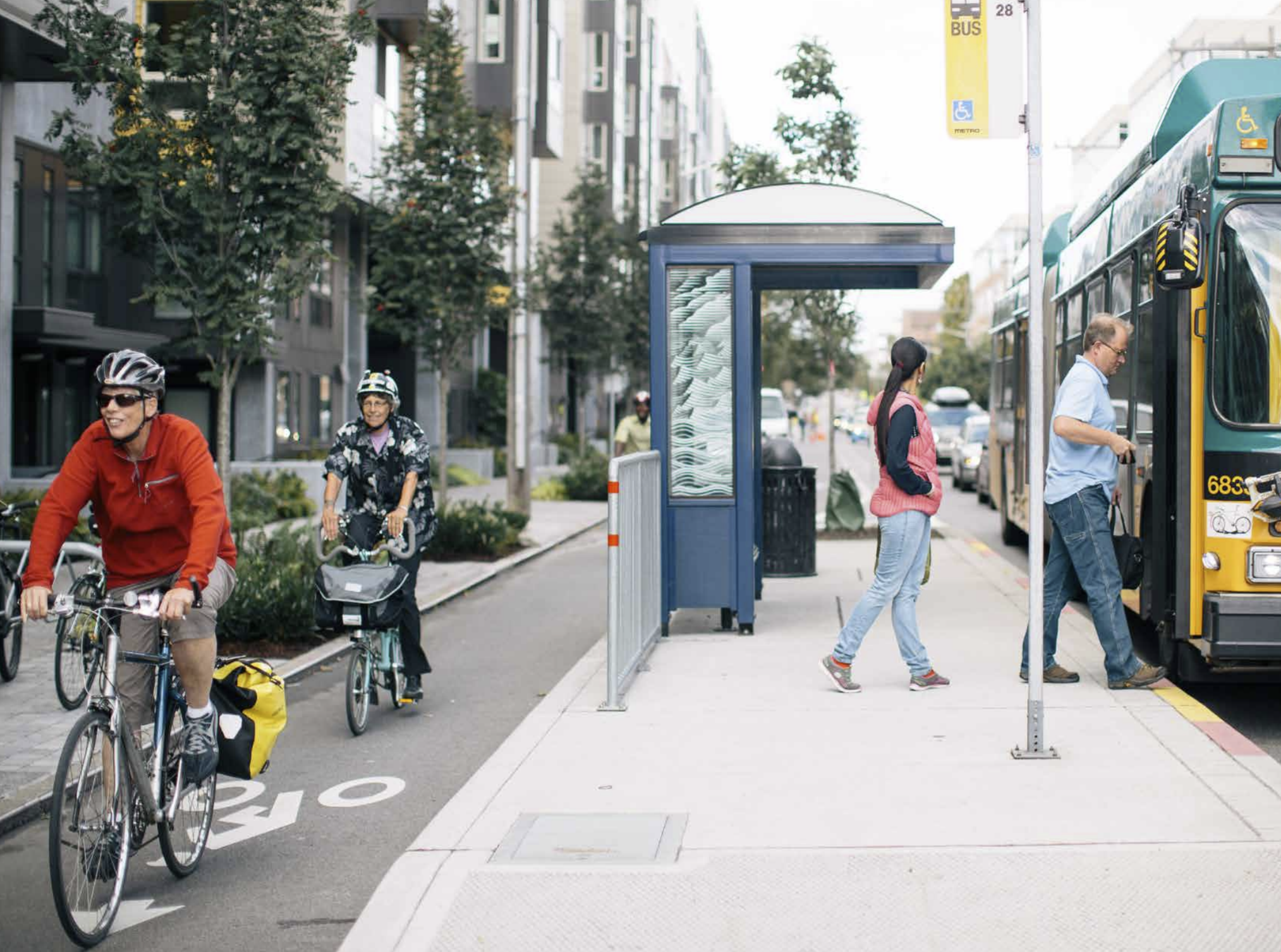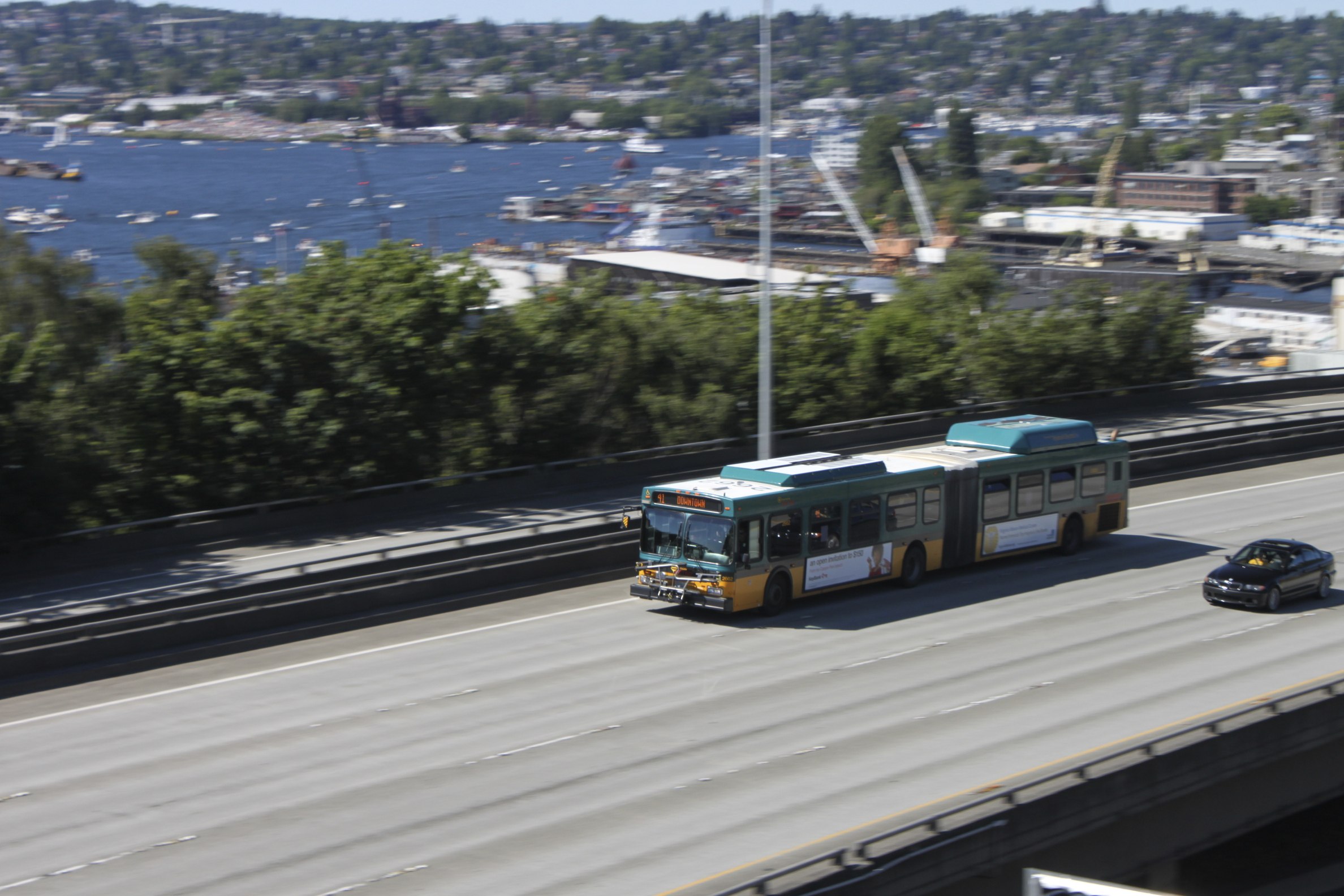
Transform Transportation
Strategies for a Healthier Future
America’s transportation system is wrecking our health and the environment. To address the damage it causes, we need to completely transform the way we get around. This means ending our reliance on fossil fuel-powered cars and giving Americans new freedom to travel in ways that are clean, convenient and beneficial to our health and our communities. Transform Transportation describes steps we can take right now, using proven policies and existing technology, that can help us to do that.

Downloads
America’s transportation system is wrecking our health.
Traffic-related air pollution kills an estimated 58,000 Americans every year, and increases the risk of serious health conditions, including lung cancer, stroke, heart disease, asthma, and even dementia.1 More than 38,000 people die in vehicle crashes in the U.S. every year and millions more are seriously injured.2 Even our mental health and the health of our relationships are at risk – the time we spend driving, much less the time we spend stuck in stressful traffic, is time away from family, friends, exercise and leisure pursuits.
These health problems are a direct result of the way we’ve built our communities and our transportation system to be dependent on travel in fossil fuel-powered cars. Every year, Americans drive more than 3.2 trillion miles – nearly 10,000 miles per person and more miles per capita than people almost anywhere else in the world.3 Since 1990, the number of vehicle miles traveled by light-duty vehicles like cars and light-duty trucks has risen by more than 46 percent.4
There is a better way.
By rebuilding our transportation system to give more people the option to spend less time in a car, by expanding access to active means of travel such as walking and biking, and by adopting zero-emission electric cars and buses, we can make our transportation safer, healthier, cleaner and more efficient.
Transportation is a leading cause of air pollution that shortens lives and makes people sick.
In 2019, the transportation sector produced 55 percent of the nation’s emissions of nitrogen oxides (NOx) – a component of ozone smog – 16 percent of all emissions of volatile organic compounds (VOCs), and 2.7 percent of all emissions of primary particulate matter, often known as soot.5
This pollution causes or exacerbates a range of serious health conditions, including:
- Cancer: Diesel exhaust is classed as a potential cancer agent by the World Health Organization and the U.S. EPA.6 Exposure to diesel exhaust has been associated with higher rates of lung cancer and greater risk for bladder cancer.7 Particulate matter and nitrogen dioxide, emitted in vehicle exhaust, have both been associated with increased risk for lung cancer.8
- Stroke: Long-term exposure to particulate matter is associated with an up to 21 percent higher risk of stroke.9
- Heart and lung disease: Exposure to nitrogen dioxide, found in vehicle exhaust, has been linked to heart and lung diseases and premature death.10 Exposure to particulate matter can result in vascular damage and accelerated decline of lung function.11
- Asthma: Exposure to vehicle exhaust causes and exacerbates childhood asthma, and recent research suggests it also damages lung development even in non-asthmatic children, leading to increased risk of respiratory and cardiovascular diseases in later life.12
- Dementia and cognitive decline among the elderly: One study estimates that between 7 and 11 percent of dementia cases among individuals living within 50 meters of a major road are attributable to traffic exposure.13
The 45 million Americans who live in close proximity to busy roads or other traffic-related infrastructure are at increased risk from the health impacts of traffic-related pollution.14
- Studies have found increased prevalence of asthma in children living within 100 meters of a freeway.15 One study estimated that over 27,000 cases of childhood asthma in Los Angeles County were at least partly attributable to pollution associated with living close to a major road.16
- Living close to a major road increases the chances of suffering from an ischemic stroke by 42 percent and significantly increases the likelihood of dying as a result.17
- Higher levels of noise and air pollution are associated with increases in coronary heart disease (CHD) mortality. One study found that individuals exposed to the highest levels of noise pollution are 22 percent more likely to die as a result of CHD than those exposed to the lowest levels.18
American society’s dependence on cars puts us at risk every time we take to the roads, whether or not we’re in a car ourselves.
- Every year, approximately 38,000 Americans are killed in car crashes, making car crashes the leading cause of death for Americans between the ages of 1 and 54.19
- In 2018, nearly 6,300 pedestrians and more than 800 cyclists were killed in traffic-related accidents, with more pedestrian and cyclist fatalities on the roads in 2018 than in any year since 1990.20
Driving even takes a toll on the health of drivers themselves. Excessive driving can lead to a range of health impacts, including: 21
- Chronic stress and poor mental health: Commuters who travel to work by car experience substantially higher levels of stress, more negative moods and lower satisfaction with life than those who took active modes of transport.22
- Obesity and high blood pressure: People with long car commutes are more likely to be obese and to have higher blood pressure. They are also less likely to do the recommended amount of physical activity, putting them at increased risk of diabetes, cardiovascular disease, osteoporosis, metabolic risk syndrome and certain kinds of cancer.23
America’s transportation system is the nation’s number one source of greenhouse gas emissions and the largest single contributor to the climate crisis, which will harm public health for decades to come.
In 2018, transportation accounted for 28 percent of the nation’s total greenhouse gas emissions – more than any other sector of the economy.24 If emissions continue at their current level, the impacts on public health will be severe.25
- Extreme temperatures will kill more people. As climate change makes extreme variations in temperature more common, deaths and hospitalizations from extreme heat and cold will rise.26
- Shifting weather patterns and high pollution will create high concentrations of ozone in some areas, causing more premature deaths and hospitalizations due to respiratory illness.27
- Climate change will bring more disease, as shifting temperatures lead to geographic shifts of disease-carrying insects like ticks and mosquitos.28 Warmer weather will increase the prevalence of pathogens like E. coli and salmonella, which thrive in hot and humid conditions.29
To address the health and environmental damage our transportation system causes, we need to completely transform the way we travel. And there are steps we can take right now, using proven policies and existing technology that can help eliminate traffic-related pollution and move America’s transportation system towards a greener, healthier future:
Getting more people moving by foot, bike and transit can immediately reduce both global warming emissions and the toxic pollutants from our car-dependent transportation system. Walking and biking infrastructure has been shown to benefit communities in a variety of ways, including increased safety, improved health and happiness, and more freedom for older adults and people with mobility issues.
The U.S. should at least double the number of people who travel by foot, bike or transit by 2030. To achieve this goal, policymakers should:
- Ensure that walking, biking and transit are safe, affordable, accessible and enjoyable through infrastructure expansion and improvements.
- End subsidies that make driving artificially cheap to help make low-carbon transportation the easiest, cheapest, most convenient option.
Phasing out fossil fuel vehicles can enable the U.S. vehicle fleet to operate with zero greenhouse gas emissions from driving or charging, if such a shift is accompanied by a transition to a grid powered by clean, renewable energy. Electric vehicles also benefit public health, as they do not emit harmful tailpipe emissions that cause cancer, asthma and other health problems.30
All new light-duty cars and trucks sold after 2035 should be electric vehicles. To achieve this goal, policymakers should:
- Set requirements to phase out fossil fuel-powered vehicles and adopt EV mandates.
- Make EVs cheaper to buy and own through tax credits and other incentives.
- Expand and improve EV charging infrastructure.
Electrifying and improving transit can create clean transit fleets for cities and schools, particularly if those fleets are powered by clean energy. Electric buses emit no tailpipe pollution and would significantly improve the health of children who take school buses and the urban populations often served by buses.31
U.S. transit agencies and school districts should replace all transit and school buses with clean electric buses by 2030. To achieve this goal, policymakers should:
- Adopt electric bus commitments at all levels of government, including at transit agencies and school districts.
- Provide transit agencies with financial and technical assistance to help them make the switch to electric buses while maintaining or increasing service.
- 58,000 air pollution deaths: Approximately 53,000 PM2.5-related deaths and 5,000 ozone-related deaths per year. Fabio Caiazzo et al., “Air Pollution and Early Deaths in the United States. Part I: Quantifying the Impact of Major Sectors in 2005,” Atmospheric Environment, 79: 198-208, doi: https://doi.org/10.1016/j.atmosenv.2013.05.081, November 2013.↩︎
- 38,000 vehicle crash deaths: 25-year average for the years 1994-2018, calculated from statistics available via the National Highway Traffic Safety Administration, accessed 20 January 2021, archived at http://web.archive.org/web/20210127234432/https://www-fars.nhtsa.dot.gov/Main/index.aspx. See also: Association for Safe International Road Travel, Road Safety Facts, accessed June 2020, archived at https://web.archive.org/web/20200728205805/https://www.asirt.org/safe-travel/road-safety-facts/. Approximately 3 million nonfatally injured: Centers for Disease Control and Prevention, Motor Vehicle Injury, accessed 20 January 2021, available at https://www.cdc.gov/publichealthgateway/didyouknow/topic/vehicle.html.↩︎
- Vehicle miles traveled for 2018: Federal Highway Administration, December 2018 Traffic Volume Trends, accessed 31 May 2019, archived at http://web.archive.org/web/20190531131845/https://www.fhwa.dot.gov/policyinformation/travel_monitoring/18dectvt/. International comparison: Vehicle miles traveled converted from vehicle kilometers traveled, United Nations Economic Commission for Europe, Motor Vehicle Movements on National Territory by Road (Vehicle-Kms), accessed 26 October 2019 at https://w3.unece.org/PXWeb2015/pxweb/en/STAT/STAT__40-TRTRANS__02-TRROAD/01_en_TRRoadVehKm_r.px/. Country population data for 2017: The World Bank, World Development Indicators – Population, downloaded 26 October 2019 from https://data.worldbank.org/indicator/sp.pop.totl?name_desc=false.↩︎
- U.S. Environmental Protection Agency, Sources of Greenhouse Gas Emissions: Transportation Sector Emissions, accessed 28 January 2021, archived at https://web.archive.org/web/20210201032453/https://www.epa.gov/ghgemissions/sources-greenhouse-gas-emissions#transportation.↩︎
- U.S. Environmental Protection Agency, Multi-Pollutant Comparison data downloaded from https://web.archive.org/web/20201102235925/https://19january2017snapshot.epa.gov/air-emissions-inventories/multi-pollutant-comparison_.html.↩︎
- U.S. Environmental Protection Agency, Integrated Risk Information System: Diesel Engine Exhaust; CASRN N.A, 28 February 2003.↩︎
- Lung cancer: Debra T. Silverman, “Diesel Exhaust Causes Lung Cancer – Now What?” Occupational Environmental Medicine, 74(4):233-234, doi: 10.1136/oemed-2016-104197, 2017. Bladder cancer: Lidija Latifovic et al., “Bladder Cancer and Occupational Exposure to Diesel and Gasoline Engine Emissions among Canadian Men,” Cancer Medicine, 4(12):1948-62, doi: 10.1002/cam4.544, December 2015.↩︎
- Lung cancer: Ibid. Particulate matter links to lung cancer: Neil J. Hime et al., “A Comparison of the Health Effects of Ambient Particulate Matter Air Pollution from Five Emission Sources,” International Journal of Environmental Research and Public Health, 15(6):1206, https://doi.org/10.3390/ijerph15061206, 2018. Nitrogen Dioxide: Richard W. Atkinson et al., “Long-term Concentrations of Nitrogen Dioxide and Mortality: A Meta-analysis of Cohort Studies,” Epidemiology, 29(4):460–472, doi: 10.1097/EDE.0000000000000847, 1 June 2018.↩︎
- Hans Scheers et al., “Long-Term Exposure to Particulate Matter Air Pollution Is a Risk Factor for Stroke,” Stroke, 46(11), https://doi.org/10.1161/STROKEAHA.115.009913, October 2015.↩︎
- Richard W. Atkinson et al., “Long-term Concentrations of Nitrogen Dioxide and Mortality: A Meta-analysis of Cohort Studies,” Epidemiology, 29(4):460–472, doi: 10.1097/EDE.0000000000000847, 1 June 2018.↩︎
- Vascular damage: Neil J. Hime et al., “A Comparison of the Health Effects of Ambient Particulate Matter Air Pollution from Five Emission Sources,” International Journal of Environmental Research and Public Health, 15(6):1206, doi: https://doi.org/10.3390/ijerph15061206, 2018. Lung function decline: Mary B. Rice et al., “Long-term Exposure to Traffic Emissions and Fine Particulate Matter and Lung Function Decline in the Framingham Heart Study,” American Journal of Respiratory and Critical Care Medicine, 191(6):656–664, doi: 10.1164/rccm.201410-1875OC, January 2015.↩︎
- Asthma: e.g., Neil J. Hime et al., “A Comparison of the Health Effects of Ambient Particulate Matter Air Pollution from Five Emission Sources,” International Journal of Environmental Research and Public Health, 15(6):1206, doi: https://doi.org/10.3390/ijerph15061206, 2018. U.S. Environmental Protection Agency, Basic Information about NO2, accessed 4 January 2021 at https://www.epa.gov/no2-pollution/basic-information-about-no2. Damages lung development: W. James Gauderman et al., “Effect of Exposure to Traffic on Lung Development from 10 to 18 Years of Age: A Cohort Study,” The Lancet, doi: https://doi.org/10.1016/S0140-6736(07)60037-3, January 2007. Increased risk of disease in later life: W. James Gauderman, Associate Professor of Preventive Medicine at the Keck School of Medicine, quoted in Jennifer Chan, “Living Near Highways Can Stunt Lungs,” USC News, 25 January 2007, archived at https://web.archive.org/web/20210127221024/https://news.usc.edu/19557/Living-Near-Highways-Can-Stunt-Lungs/.↩︎
- Hong Chen et al., “Living Near Major Roads and the Incidence of Dementia, Parkinson’s Disease, and Multiple Sclerosis: a Population-based Cohort Study,” The Lancet, 389(10070):718-726, doi: https://doi.org/10.1016/S0140-6736(16)32399-6, February 2017, available at http://uploads.tapatalk-cdn.com/files-1235/roads.pdf. See also: Christopher Ingraham, “Air Pollution Is Getting Worse, and Data Show More People are Dying,” Washington Post, 23 October 2019, archived at https://web.archive.org/web/20200728232746/https://www.washingtonpost.com/business/2019/10/23/air-pollution-is-getting-worse-data-show-more-people-are-dying/.↩︎
- U.S. Environmental Protection Agency, Research on Near Roadway and Other Near Source Air Pollution, accessed 14 December 2020 at https://www.epa.gov/air-research/research-near-roadway-and-other-near-source-air-pollution. Health Effects Institute Panel on the Health Effects of Traffic-Related Air Pollution, Traffic-Related Air Pollution: A Critical Review of the Literature on Emissions, Exposure, and Health Effects. Health Effects Institute: Boston, 2010.↩︎
- P. van Vliet, “Motor Vehicle Exhaust and Chronic Respiratory Symptoms in Children Living near Freeways,” Environmental Research, 74(2):122-32, doi: 10.1006/enrs.1997.3757, 1997. N. Ji et al., “Personal Exposure to Black Carbon, Nitrogen Dioxide, and Chronic Psychosocial Stress: Impacts on Childhood Asthma Exacerbation in a Seaport-Adjacent Community,” American Journal of Respiratory and Critical Care Medicine, 195:A4803, 2017, available at American Thoracic Society International Conference Abstracts, http://www.atsjournals.org/doi/abs/10.1164/ajrccm-conference.2017.195.1_…. Andrea J Venn et al., “Living Near a Main Road and the Risk of Wheezing Illness in Children,” American Journal of Respiratory and Critical Care Medicine, 164(12), doi: https://doi.org/10.1164/ajrccm.164.12.2106126, 2001.↩︎
- Laura Perez et al., “Near-Roadway Pollution and Childhood Asthma: Implications for Developing ‘Win-Win’ Compact Urban Development and Clean Vehicle Strategies,” Environmental Health Perspectives, 120(11):1619–1626, doi: 10.1289/ehp.1104785, 2012.↩︎
- 42 percent: Erin Kulick et al., “Residential Proximity to Major Roadways and Risk of Incident Ischemic Stroke in NOMAS (The Northern Manhattan Study),” Stroke, 49(4):835–841, doi: https://doi.org/10.1161/STROKEAHA.117.019580Stroke, March 2018. Post-stroke mortality: Elissa H. Wilker et al., “Residential Proximity to High-traffic Roadways and Poststroke Mortality,” Journal of Stroke and Cerebrovascular Diseases, 22(8):e366-72, doi: 10.1016/j.jstrokecerebrovasdis.2013.03.034, 2013.↩︎
- Wen Qi Gan et al., “Association of Long-term Exposure to Community Noise and Traffic-related Air Pollution with Coronary Heart Disease Mortality,” American Journal of Epidemiology, 175(9):898-906, doi: 10.1093/aje/kwr424, April 2012. For a detailed overview of current research on the health effects of traffic-related noise pollution, see Thomas Münzel et al., “The Adverse Effects of Environmental Noise Exposure on Oxidative Stress and Cardiovascular Risk,” Antioxidants and Redox Signaling, 28(9):873–908, doi: 10.1089/ars.2017.7118, March 2018.↩︎
- 38,000 vehicle crash deaths: see note 2. Leading cause of death: Association for Safe International Road Travel, Road Safety Facts, accessed June 2020, archived at https://web.archive.org/web/20200728205805/https://www.asirt.org/safe-travel/road-safety-facts/.↩︎
- 6,300 pedestrians, 800+ cyclists: National Highway Traffic Safety Administration, 2018 Fatal Motor Vehicle Crashes: Overview, October 2019, available at https://crashstats.nhtsa.dot.gov/Api/Public/ViewPublication/812826. U.S. Department of Transportation National Highway Traffic Safety Administration, Pedestrian Safety, accessed 27 January 2021, archived at https://web.archive.org/web/20210127234553/https://www.nhtsa.gov/road-safety/pedestrian-safety.↩︎
- Annette Schaefer, “Commuting Takes Its Toll,” Scientific American, 1 October 2005, archived at https://web.archive.org/web/20210127235034/https://www.scientificamerican.com/article/commuting-takes-its-toll/.↩︎
- Higher levels of stress and more negative moods: R.E. Wener at al., “Comparing Stress of Car and Train Commuters,” Transportation Research Part F: Traffic Psychology and Behaviour, 14(2):111–116, doi: 10.1016/j.trf.2010.11.008, March 2011. Lower satisfaction with life: Margo Hilbrecht et al., “Highway to Health? Commute Time and Well-being Among Canadian Adults,” World Leisure Journal, 56(2):151-163, doi:10.1080/16078055.2014.903723, 2014. See also Amy Morin, “Your Commute Could Be Killing Your Happiness,” Psychology Today, 30 June 2015, available at https://www.psychologytoday.com/us/blog/what-mentally-strong-people-dont-do/201506/your-commute-could-be-killing-your-happiness.↩︎
- Obesity/exercise/blood pressure: C.M. Hoehner et al., “Commuting Distance, Cardiorespiratory Fitness, and Metabolic Risk,” American Journal of Preventive Medicine, 42(6), doi: 10.1016/j.amepre.2012.02.020, June 2012. Diabetes, cardiovascular disease, osteoporosis, metabolic risk syndrome: M. Hilbrecht et al., “Highway to Health? Commute Time and Well-being Among Canadian Adults,” World Leisure Journal, 56(2):151-163, doi: https://doi.org/10.1080/16078055.2014.903723, 2014, 153. Cardiovascular disease, diabetes and cancers: Reuters Staff, “Long Commutes May Be Bad for Health: Study,” Reuters, 8 May 2012, archived at https://web.archive.org/web/20210128003742/https://www.reuters.com/article/us-commuting/long-commutes-may-be-bad-for-health-study-idUSBRE8470U520120508. Lawrence Frank et al., “Obesity Relationships with Community Design, Physical Activity, and Time Spent in Cars,” American Journal of Preventive Medicine, 27(2):87–96, doi: 10.1016/j.amepre.2004.04.011, 2004.↩︎
- U.S. Environmental Protection Agency, Inventory of U.S. Greenhouse Gas Emissions and Sinks, accessed 29 January 2021, archived at https://web.archive.org/web/20210129222917/https://www.epa.gov/ghgemissions/inventory-us-greenhouse-gas-emissions-and-sinks.↩︎
- U.S Global Change Research Program, The Impacts of Climate Change on Human Health in the United States: A Scientific Assessment, April 2016, available at https://health2016.globalchange.gov/high/ClimateHealth2016_FullReport.pdf.↩︎
- Ibid.↩︎
- Ibid.↩︎
- Ibid.↩︎
- Ibid.↩︎
- Jordan Schnell et al., “Air Quality Impacts from the Electrification of Light-Duty Passenger Vehicles in the United States,” Atmospheric Environment, 208:95-102, doi: 10.1016/j.atmosenv.2019.04.003, 1 July 2019.↩︎
- California Air Resources Board, California Transitioning to All-Electric Public Bus Fleet by 2040, 14 December 2018, archived at http://web.archive.org/web/20191004045224/https://ww2.arb.ca.gov/news/ca….↩︎
Topics
Authors
James Horrox
Policy Analyst, Frontier Group
James Horrox is a policy analyst at Frontier Group, based in Los Angeles. He holds a BA and PhD in politics and has taught at Manchester University, the University of Salford and the Open University in his native UK. He has worked as a freelance academic editor for more than a decade, and before joining Frontier Group in 2019 he spent two years as a prospect researcher in the Public Interest Network's LA office. His writing has been published in various media outlets, books, journals and reference works.
Gideon Weissman
Former Policy Analyst, Frontier Group
Matt Casale
Former Director, Environment Campaigns, U.S. PIRG Education Fund
Find Out More

Highway Boondoggles

Less driving is possible

How much land will a renewable energy system use?


